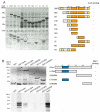Corto and DSP1 interact and bind to a maintenance element of the Scr Hox gene: understanding the role of Enhancers of trithorax and Polycomb
- PMID: 16613610
- PMCID: PMC1459216
- DOI: 10.1186/1741-7007-4-9
Corto and DSP1 interact and bind to a maintenance element of the Scr Hox gene: understanding the role of Enhancers of trithorax and Polycomb
Abstract
Background: Polycomb-group genes (PcG) encode proteins that maintain homeotic (Hox) gene repression throughout development. Conversely, trithorax-group (trxG) genes encode positive factors required for maintenance of long term Hox gene activation. Both kinds of factors bind chromatin regions called maintenance elements (ME). Our previous work has shown that corto, which codes for a chromodomain protein, and dsp1, which codes for an HMGB protein, belong to a class of genes called the Enhancers of trithorax and Polycomb (ETP) that interact with both PcG and trxG. Moreover, dsp1 interacts with the Hox gene Scr, the DSP1 protein is present on a Scr ME in S2 cells but not in embryos. To understand better the role of ETP, we addressed genetic and molecular interactions between corto and dsp1.
Results: We show that Corto and DSP1 proteins co-localize at 91 sites on polytene chromosomes and co-immunoprecipitate in embryos. They interact directly through the DSP1 HMG-boxes and the amino-part of Corto, which contains a chromodomain. In order to search for a common target, we performed a genetic interaction analysis. We observed that corto mutants suppressed dsp11 sex comb phenotypes and enhanced AntpScx phenotypes, suggesting that corto and dsp1 are simultaneously involved in the regulation of Scr. Using chromatin immunoprecipitation of the Scr ME, we found that Corto was present on this ME both in Drosophila S2 cells and in embryos, whereas DSP1 was present only in S2 cells.
Conclusion: Our results reveal that the proteins Corto and DSP1 are differently recruited to a Scr ME depending on whether the ME is active, as seen in S2 cells, or inactive, as in most embryonic cells. The presence of a given combination of ETPs on an ME would control the recruitment of either PcG or TrxG complexes, propagating the silenced or active state.
Figures





Similar articles
-
The enhancer of trithorax and polycomb corto interacts with cyclin G in Drosophila.PLoS One. 2008 Feb 20;3(2):e1658. doi: 10.1371/journal.pone.0001658. PLoS One. 2008. PMID: 18286205 Free PMC article.
-
Rm62, a DEAD-box RNA helicase, complexes with DSP1 in Drosophila embryos.Genesis. 2010 Apr;48(4):244-53. doi: 10.1002/dvg.20609. Genesis. 2010. PMID: 20196121
-
DSP1, a Drosophila HMG protein, is involved in spatiotemporal expression of the homoeotic gene Sex combs reduced.Biol Cell. 2005 Oct;97(10):779-85. doi: 10.1042/BC20040508. Biol Cell. 2005. PMID: 15610064
-
Maintenance of Hox gene expression patterns.Adv Exp Med Biol. 2010;689:41-62. doi: 10.1007/978-1-4419-6673-5_3. Adv Exp Med Biol. 2010. PMID: 20795321 Review.
-
Functions of mammalian Polycomb group and trithorax group related genes.Curr Opin Genet Dev. 1997 Aug;7(4):488-94. doi: 10.1016/s0959-437x(97)80075-5. Curr Opin Genet Dev. 1997. PMID: 9309179 Review.
Cited by
-
New partners in regulation of gene expression: the enhancer of Trithorax and Polycomb Corto interacts with methylated ribosomal protein l12 via its chromodomain.PLoS Genet. 2012;8(10):e1003006. doi: 10.1371/journal.pgen.1003006. Epub 2012 Oct 11. PLoS Genet. 2012. PMID: 23071455 Free PMC article.
-
Polycomb group response elements in Drosophila and vertebrates.Adv Genet. 2013;81:83-118. doi: 10.1016/B978-0-12-407677-8.00003-8. Adv Genet. 2013. PMID: 23419717 Free PMC article. Review.
-
The MAP kinase ERK and its scaffold protein MP1 interact with the chromatin regulator Corto during Drosophila wing tissue development.BMC Dev Biol. 2011 Mar 14;11:17. doi: 10.1186/1471-213X-11-17. BMC Dev Biol. 2011. PMID: 21401930 Free PMC article.
-
Drosophila Cyclin G and epigenetic maintenance of gene expression during development.Epigenetics Chromatin. 2015 May 7;8:18. doi: 10.1186/s13072-015-0008-6. eCollection 2015. Epigenetics Chromatin. 2015. PMID: 25995770 Free PMC article.
-
A Distalless-responsive enhancer of the Hox gene Sex combs reduced is required for segment- and sex-specific sensory organ development in Drosophila.PLoS Genet. 2018 Apr 10;14(4):e1007320. doi: 10.1371/journal.pgen.1007320. eCollection 2018 Apr. PLoS Genet. 2018. PMID: 29634724 Free PMC article.
References
-
- Ingham PW. A clonal analysis of the requirement for the trithorax gene in the diversification of segments in Drosophila. J Embryol Exp Morphol. 1985;89:349–365. - PubMed
Publication types
MeSH terms
Substances
LinkOut - more resources
Full Text Sources
Molecular Biology Databases

